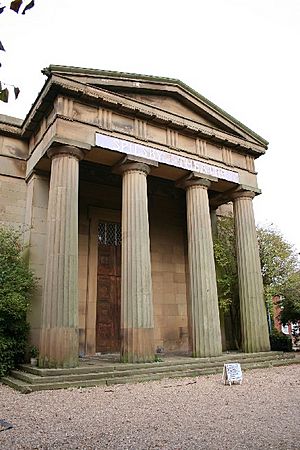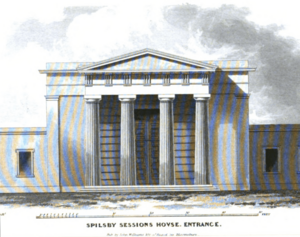Henry Edward Kendall facts for kids
Henry Edward Kendall (born March 23, 1776 – died January 4, 1875) was a famous English architect. He designed many different types of buildings, from grand public spaces to prisons and hospitals. He was known for using various styles, including Greek, Italian, and Tudor designs.
Contents
A Creative Architect's Journey
Henry Edward Kendall learned his skills from well-known architects like Thomas Leverton and possibly John Nash. He was very flexible in his designs, using styles like the ancient Greek look, the elegant Italian style, and the classic Tudor revival style.
His son, Henry Edward Kendall Jr., also became an architect. For a while, they worked together. One of their cool projects was the Esplanade and Tunnel in Kemp Town, Brighton, built between 1828 and 1830.
Working with Other Architects
Lewis Cubitt, who married Kendall's daughter Sophia in 1830, also worked at Kendall's office before starting his own business. Both Kendall and Cubitt were among the people who helped create what is now the Royal Institute of British Architects. This is a very important group for architects in Britain.
Designing Public Buildings
Kendall designed many public buildings. These included places like workhouses (buildings where poor people could live and work), hospitals, and schools. In 1832, he won a prize for his Gothic design for Kensal Green Cemetery. His Italian-style design was also a runner-up. However, his designs were not chosen for the cemetery. Instead, a Greek-style design by John William Griffith was picked. The cemetery does have a monument for Kendall's son, which is thought to have been designed by Kendall himself.
Henry Edward Kendall passed away in Westminster on January 4, 1875. He was 98 years old.
Kendall's Work in Lincolnshire
Some of Kendall's first projects were in Lincolnshire, a county in England. Here, he became known for designing Court or Session houses and prisons. His first works were the Spalding House of Correction in 1824 and the Spilsby Sessions House from 1824 to 1826.
Spalding House of Correction
The Spalding House of Correction was built in the Sheep Market area. It cost about £15,000 to build. By 1834, this prison had 45 sleeping cells and seven dayrooms. In 1842, it had even more space, with 48 sleeping cells, sixteen dayrooms, and seven yards. It also had a house for the governor, a chapel, and a treadmill. The prison was taken over by the government in 1878 and closed in 1884. It was later taken down in the 1920s.
Spilsby and Louth Prisons
Kendall also built a very similar prison block in Spilsby around 1824 to 1826. At Spilsby, an impressive court building, called a Sessions House, was added to the front of the prison. It had a grand entrance with Doric columns. The outside of the Sessions House used Ancaster stone, while the columns were made from stone found near Barnsley. After Spilsby, Kendall designed another prison in Louth in Lincolnshire around 1828.
Sleaford and Other Projects
In 1828, Kendall won a competition to build the Sessions House in Sleaford. He designed this building in a Tudor Gothic style. Kendall worked closely with a local builder and architect named Charles Kirk on this project.
After the Sessions House, Kendall designed Carr's Hospital in Sleaford in 1830. He also helped remodel Haverholme Priory in a Tudor Gothic style. He added to Aswarby Park between 1836 and 1838, and designed Fishtoft Rectory.
Gallery: Works by Kendall












